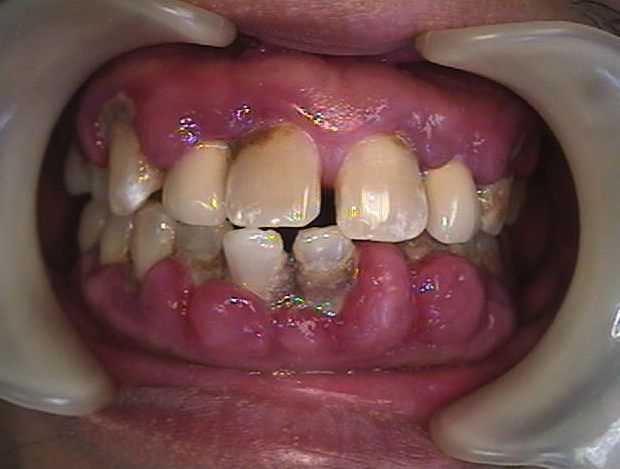
This photo documents the effects of using Calcium Channel blockers with inadequate periodontal maintenance. Calcium Channel blockers are commonly used to treat high blood pressure, angina pectoris and coronary artery disease. Physicians should obtain periodontal clearance before prescribing such medication. Periodontal therapy gum treatment began with scaling and root planing.
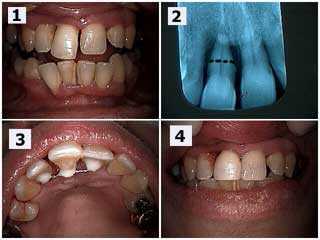
Periodontal treatment of a loose upper front tooth including scaling and root planing. How to pictures.
1) The upper right central incisor tooth has grown vertically down and moved horizontally toward the lip because of a severe gum infection. A diastema – a tooth gap space has occurred. 2) A radiograph x-ray shows severe bone loss. The black dotted line shows the location for a potential root resection if necessary. The dental hygienist performed scaling and root planing after a teeth splint was placed on the palatal surfaces of the upper anterior teeth. The patient will be reexamined by the Periodontist in three months to reevaluate periodontal healing and the potential need for the root resection. 3) Palatal photo of the dental splint between teeth #’s 7 – 9. 4) Post-op photo taken later the same day. Notice the diastema space was closed with dental bonding to hide the splint and the incisal edge of the front tooth was shortened. This treatment plan acknowledges the poor prognosis of this tooth and focuses on the patient’s strong desire to try to save at least part of it — and a desire to reduce cost. There are certainly many other treatment options that could have been considered.
1) The upper right central incisor tooth has grown vertically down and moved horizontally toward the lip because of a severe gum infection. A diastema – a tooth gap space has occurred. 2) A radiograph x-ray shows severe bone loss. The black dotted line shows the location for a potential root resection if necessary. The dental hygienist performed scaling and root planing after a teeth splint was placed on the palatal surfaces of the upper anterior teeth. The patient will be reexamined by the Periodontist in three months to reevaluate periodontal healing and the potential need for the root resection. 3) Palatal photo of the dental splint between teeth #’s 7 – 9. 4) Post-op photo taken later the same day. Notice the diastema space was closed with dental bonding to hide the splint and the incisal edge of the front tooth was shortened. This treatment plan acknowledges the poor prognosis of this tooth and focuses on the patient’s strong desire to try to save at least part of it — and a desire to reduce cost. There are certainly many other treatment options that could have been considered.
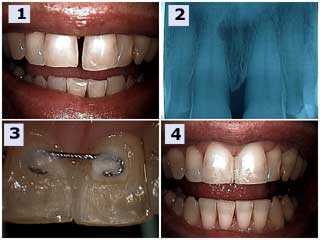
Before and After gum treatment of a periodontally involved upper left central incisor tooth #9. 1) & 2) Pre-operative photograph and radiograph x-ray. Note the angular bony defect in the radiograph. The patient reported that the tooth was getting longer and that he never previously had the space between his two front teeth. 3) Palatal photo of the teeth splint placed between teeth #’s 8 & 9. 4) Post-operative photo taken one hour later. Dental bonding was placed between the teeth to close the teeth gap also hides the palatal splint. The incisal edge of #9 was shortened and the occlusion teeth bite was checked and adjusted for fremitus. Scaling and root planing was next performed and the patient was placed on a three-month periodontal reevaluation because there was minimal post op periodontal pocketing and no bleeding upon probing.
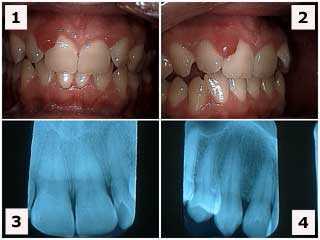
Acute periodontal abscess that did not cause gum pain. This patient had not been to the dentist for over two years. The x-rays look normal. He received a dental prophylaxis teeth cleaning with the dental hygienist and was placed on a chlorhexidene mouthwash. He was rescheduled for scaling and root planing and then further reevaluation with the Periodontist.
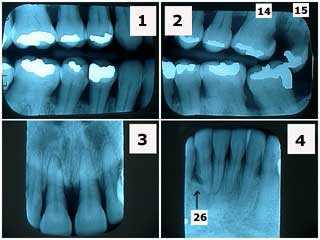
These x-rays shows severe periodontal gum disease in a 40-year-old female dental fear phobia patient. Note the significant horizontal bone loss and the lack of radiographic calculus. Tooth #26, adjacent to the vertical bony defect, is probably hopeless. This patient was treated with two rounds of scaling and root planing then scheduled for reevaluation with the Periodontist. Tooth #15 was extracted and #14 had root canal therapy and a dental crown. Two rounds of scaling and planing is typically recommended for more severe gum disease before considering other more aggressive periodontal treatment like gum surgery.
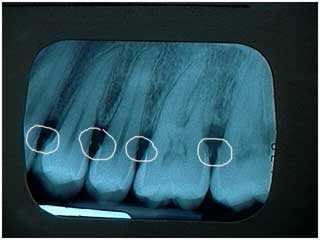
Radiographic calculus. Calculus is plaque bacteria that becomes hardened by absorbing salivary calcium and then becomes evident on dental x-rays. It usually indicates there is a chronic presence of plaque and is a source of gum infection. A dental prophylaxis teeth cleaning and then probably scaling and root planing is usually recommended treatment and frequently followed by periodontal reevaluation. Gum symptoms associated with tooth calculus can include bleeding gums, swollen gums, gum pain and bad breath.
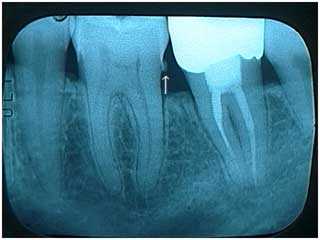
Radiographic calculus. Calculus is plaque bacteria that becomes hardened by absorbing salivary calcium and then becomes evident on x-rays. A dental prophylaxis and then probably scaling and root planing is usually recommended. These gum treatment procedures are usually performed by a dental hygienist.
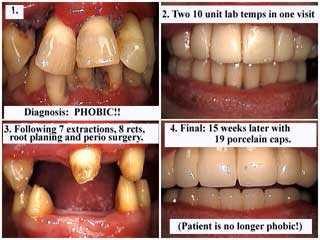
Full Mouth Oral Rehabilitation on a Dental Phobia patient that includes Scaling and Root Planing. Before and After pictures. Treatment included: 7 teeth extractions, 8 root canal treatments with composite resin cores, full mouth scaling and root planing and then periodontal gum surgery. 19 teeth of porcelain dental bridgework – teeth crowns – were placed over 8 abutments after the gums healed about 15 weeks later. Photo #1 of 2.
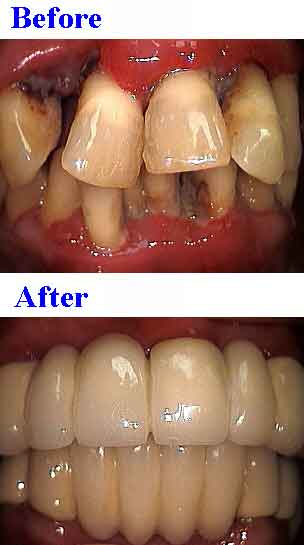
Full Mouth Dental Reconstruction that included scaling and root planing: Close up Photos. A dental hygienist is a very important part of the dental reconstruction team. Photo #2 of 2.

Pyogenic granuloma on the gingival papilla – gum point – between two teeth of a 40-year-old male. The radiographs x-rays did not reveal oral pathology. The gum tissue was firm and did not respond to scaling and root planing. There was not gum pain and it did not bleed upon periodontal probing. Initial diagnosis: irritation fibroma. The tissue was sent for biopsy; the oral pathology report indicated it was a pyogenic granuloma. Photo 1 of 3.
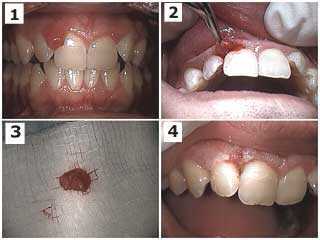
Pyogenic granuloma on the gingival papilla between two teeth of a 40-year-old male. The x-rays did not reveal oral pathology. The tissue was firm and did not respond to scaling and root planing. It did not hurt and did not bleed upon probing. Gum treatment: oral surgery excision. The gum tissue was sent for biopsy; the oral pathology report indicated it was a pyogenic granuloma. Photo 2 of 3.
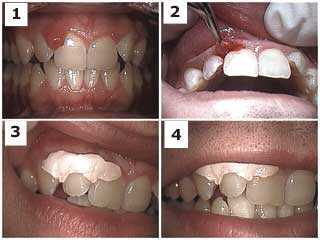
Pyogenic granuloma on the gingival papilla between two teeth. The radiographs did not reveal oral pathology. The gum tissue was firm and did not respond to scaling and root planing SRP. There was no gum pain and it did not bleed upon probing. Gum treatment: oral surgery wound site after excision and placement of Coe-pak periodontal wound dressing. The gum tissue was sent for biopsy; the oral pathology report indicated it was a pyogenic granuloma. Photo 3 of 3.

Full mouth dental reconstruction of a dental phobia patient that included scaling and root planing. Initial visit pictures and x-ray. Calculus is visible on many of these teeth. It is important to determine what teeth, if any, may be saved at least temporarily. It is easier for a patient to emotionally adjust to a temporary prosthesis that has at least some amount of retention provided by natural teeth abutments. The teeth chosen to at least initially save were #6, 11, 22 and 28. These teeth received periodontal scaling and root planing. Photo #1 of 2.
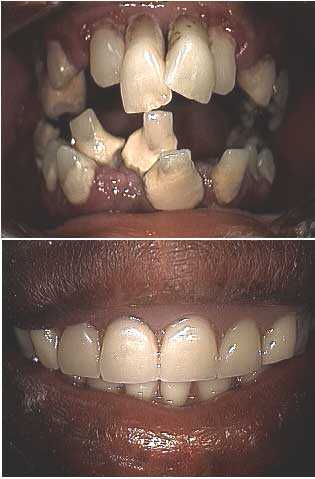
Full mouth oral rehabilitation of a dental fear patient that included scaling and root planing. Initial result Before and After pictures – two visits. Calculus is visible on many of these teeth. Scaling and Root Planing was performed along with other dental treatment. Gum symptoms associated with tooth calculus can include bleeding gums, swollen gums, gum pain and bad breath. Photo #2 of 2.